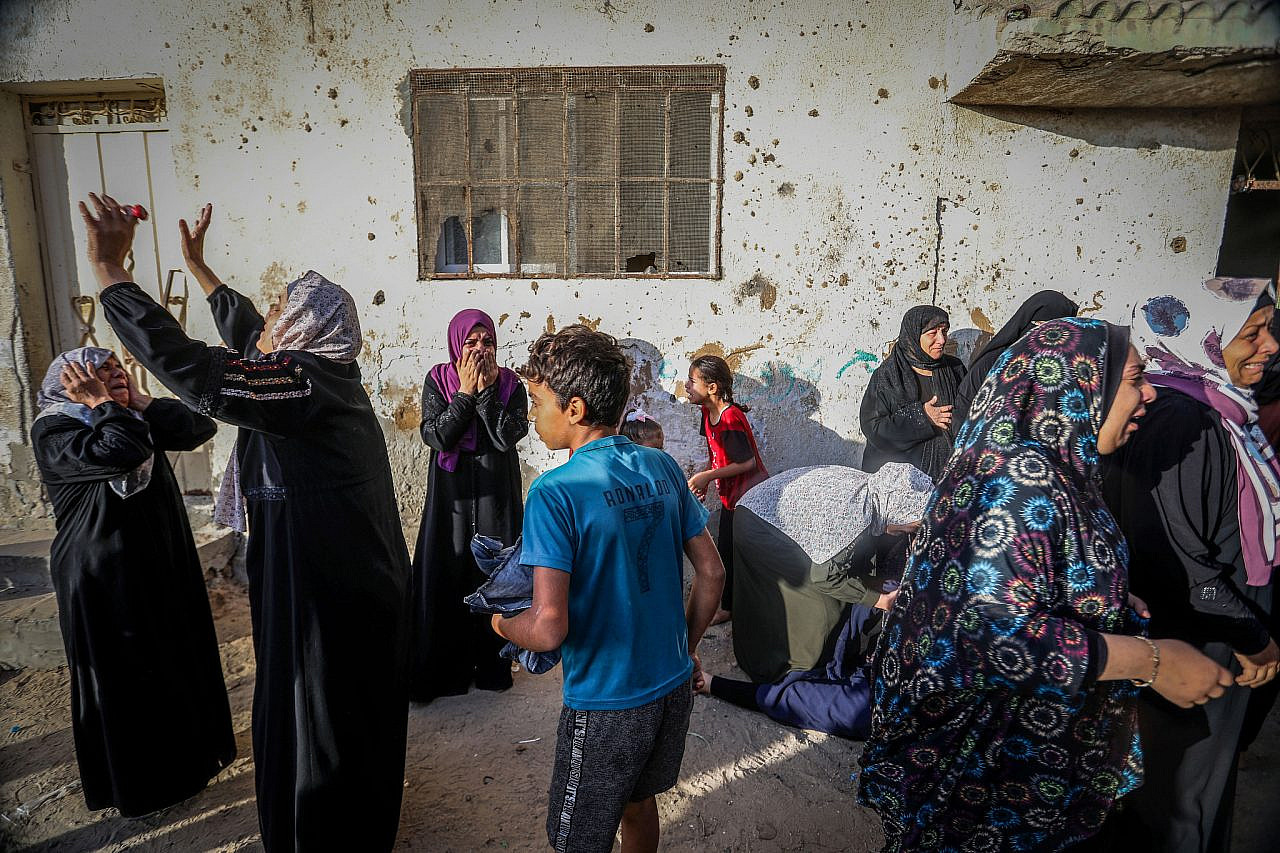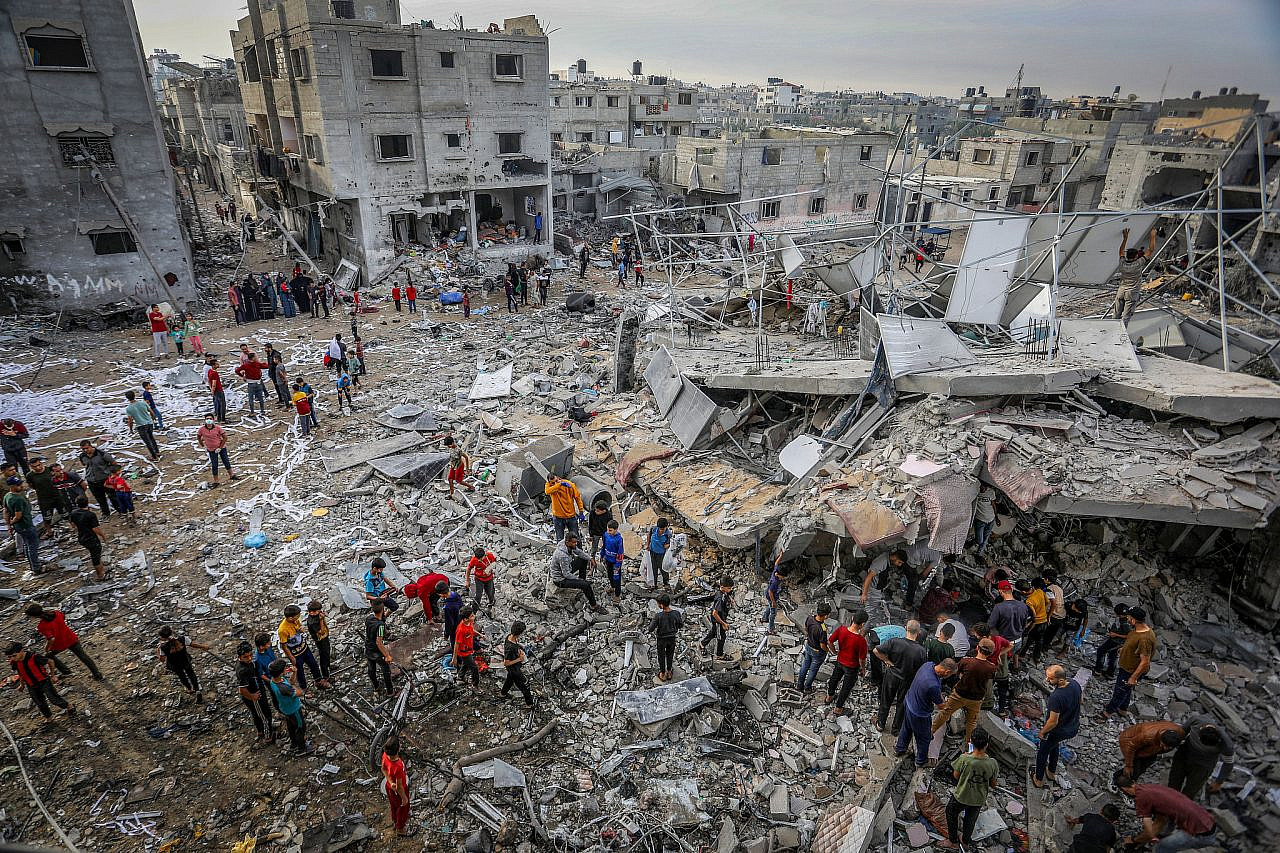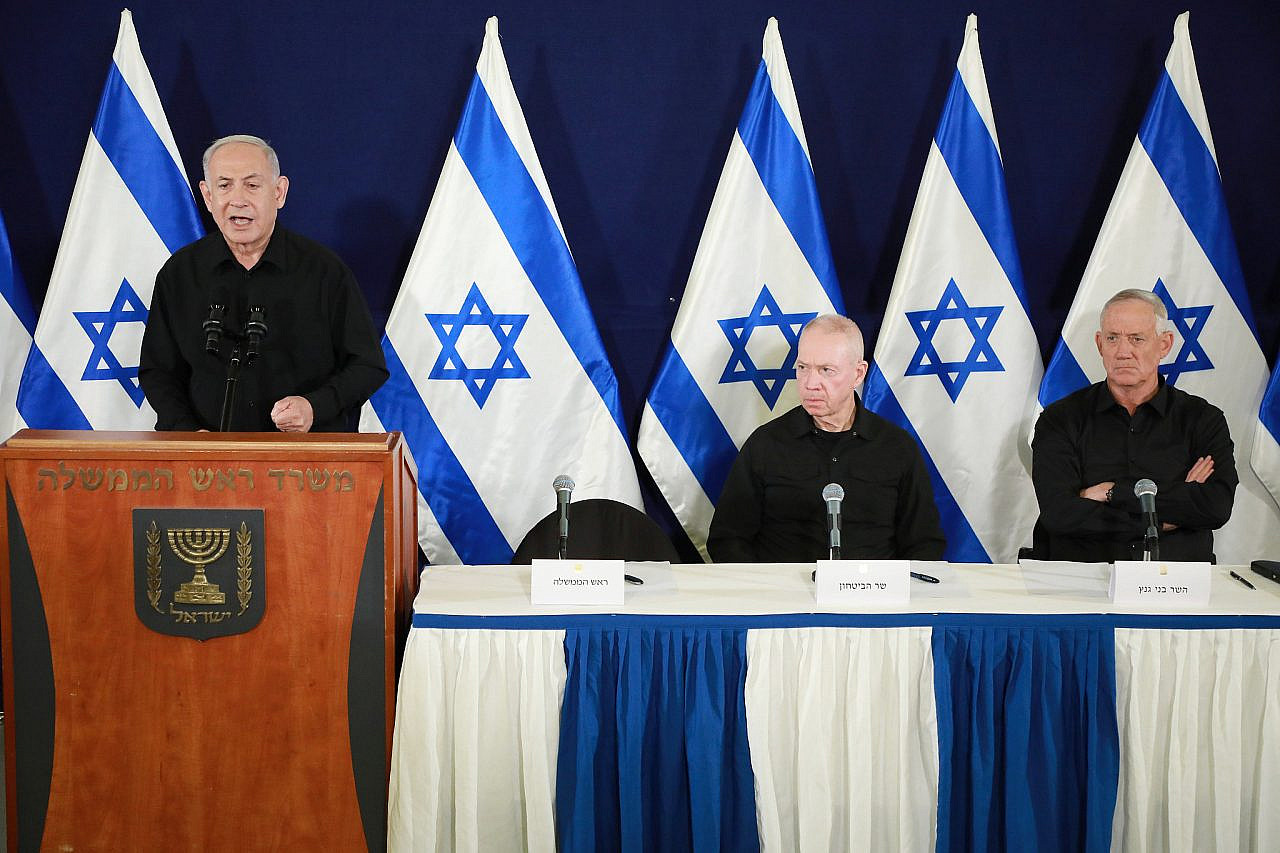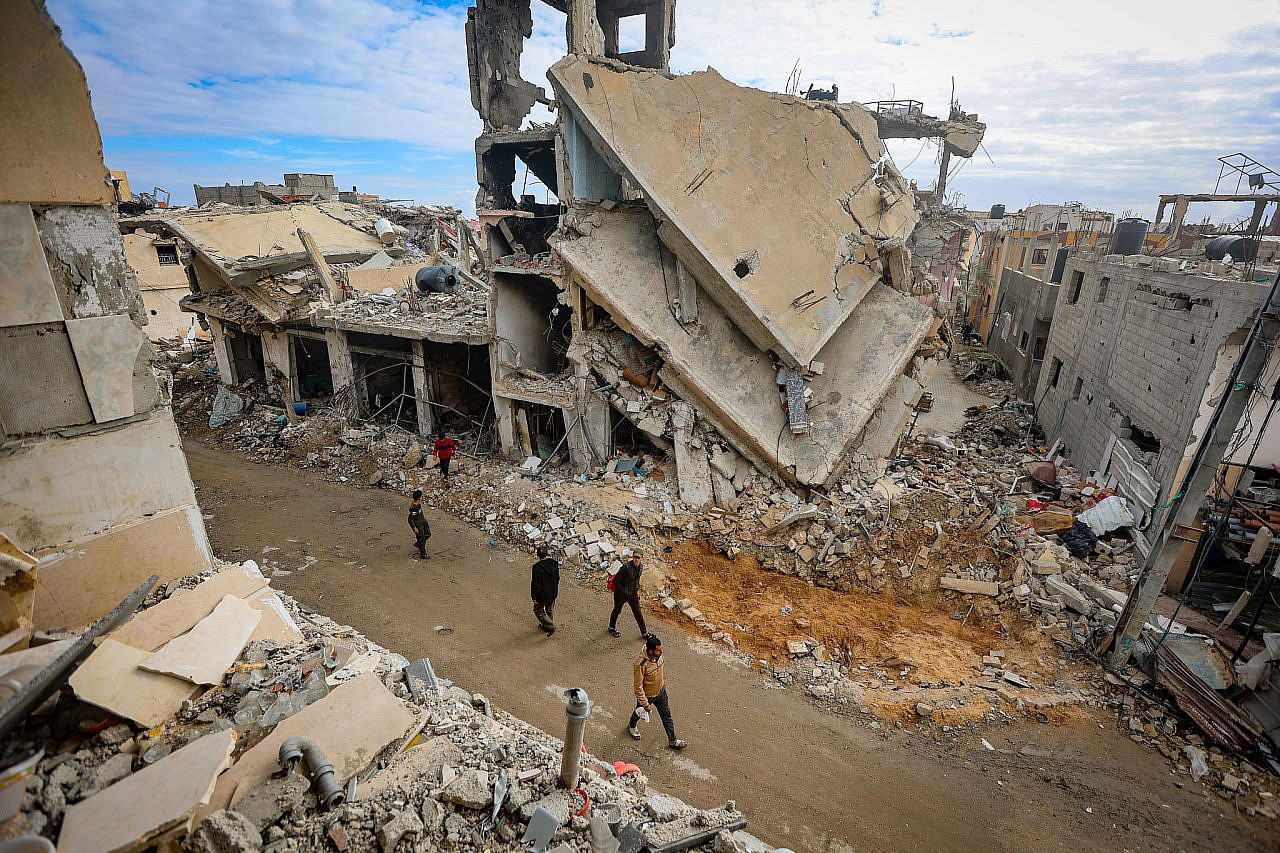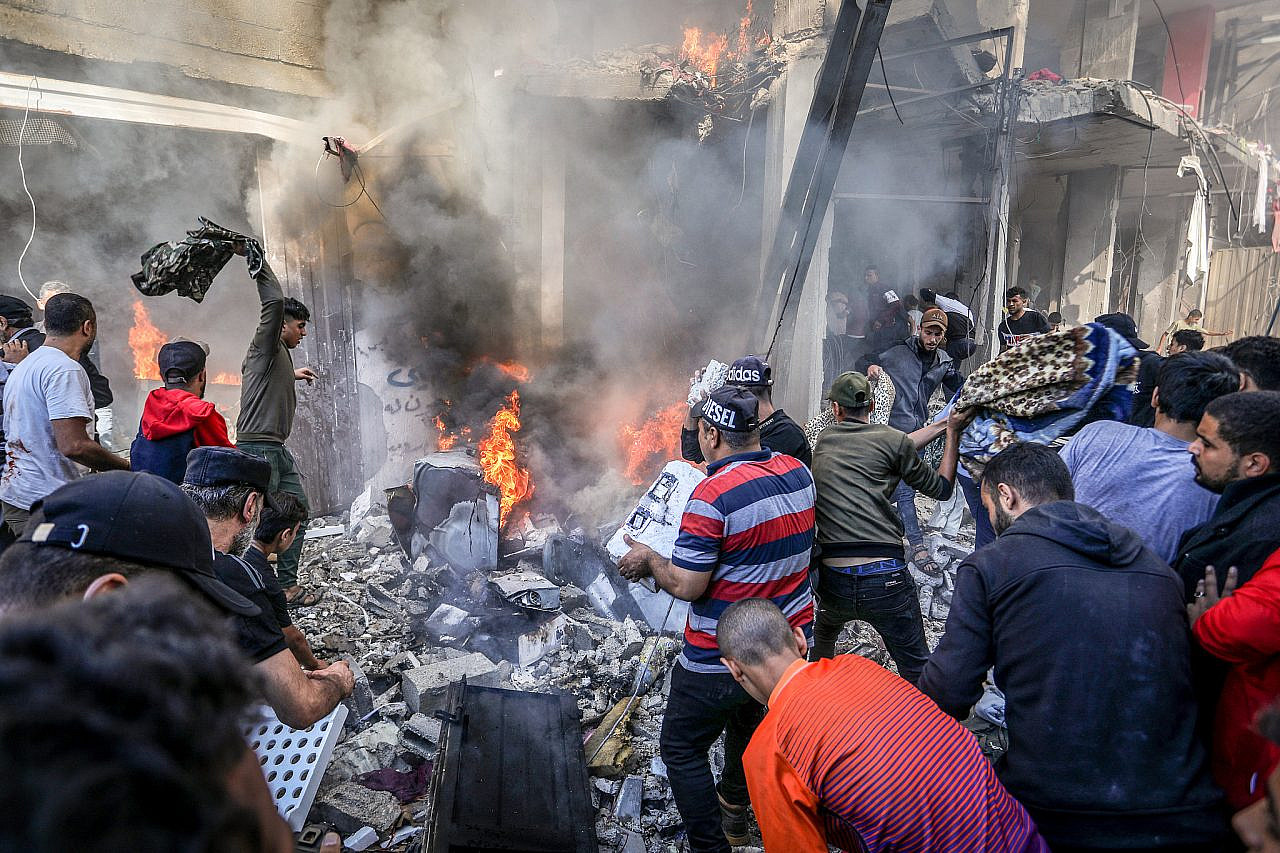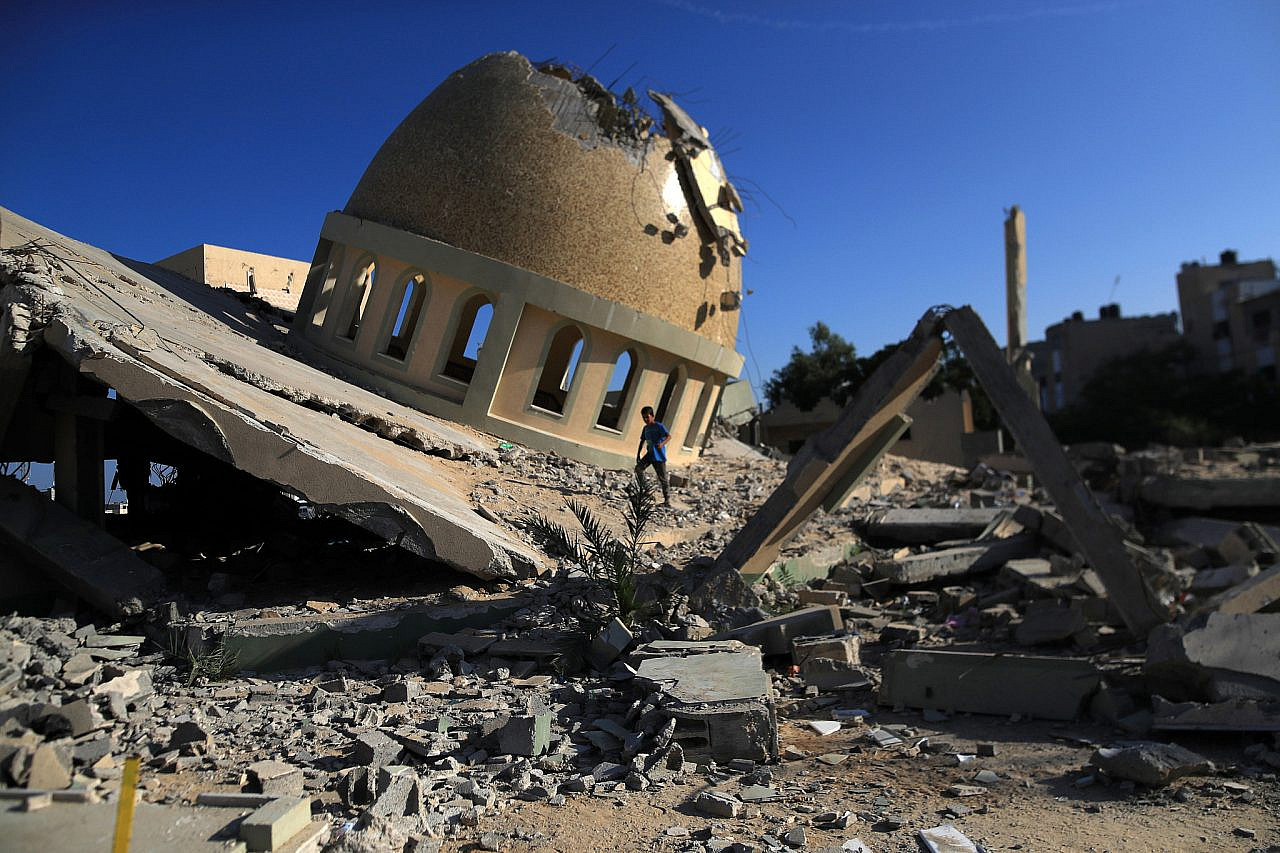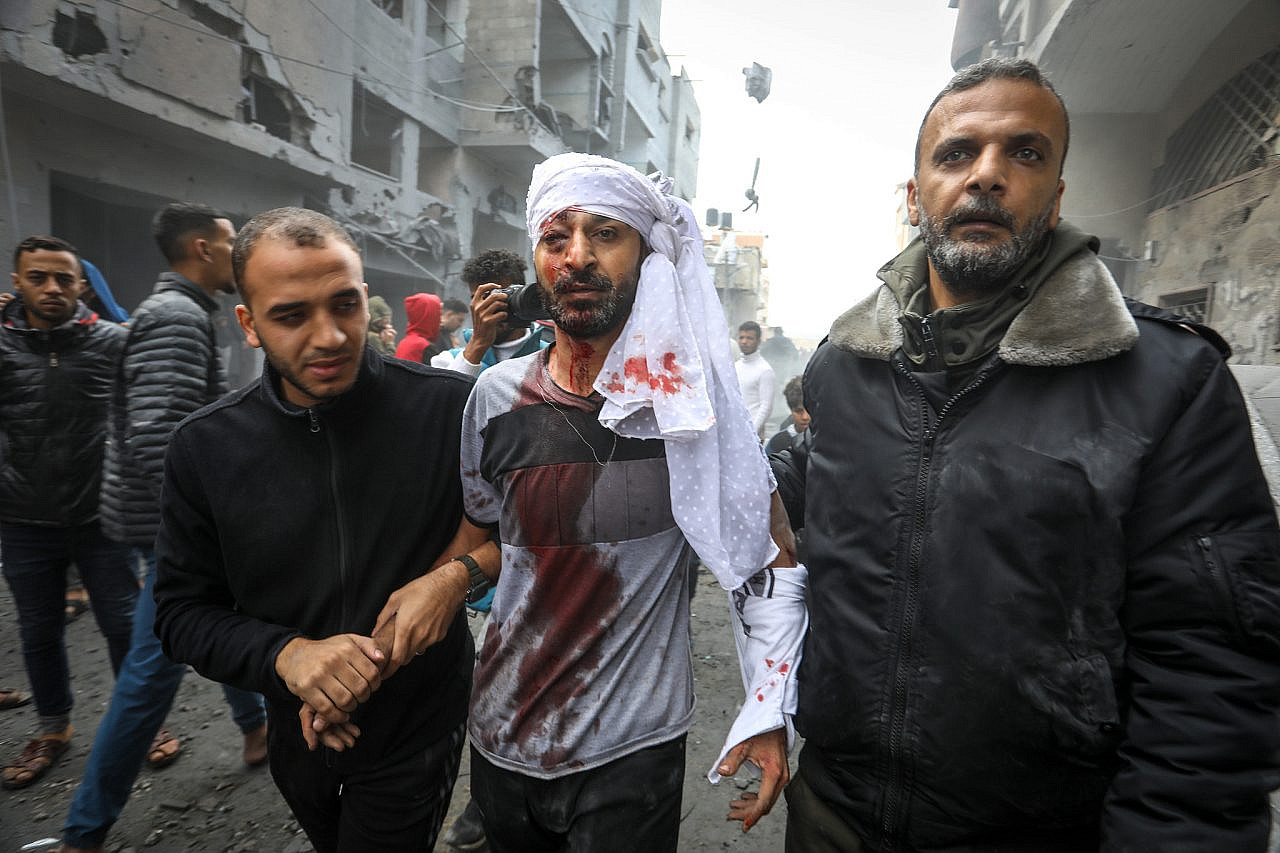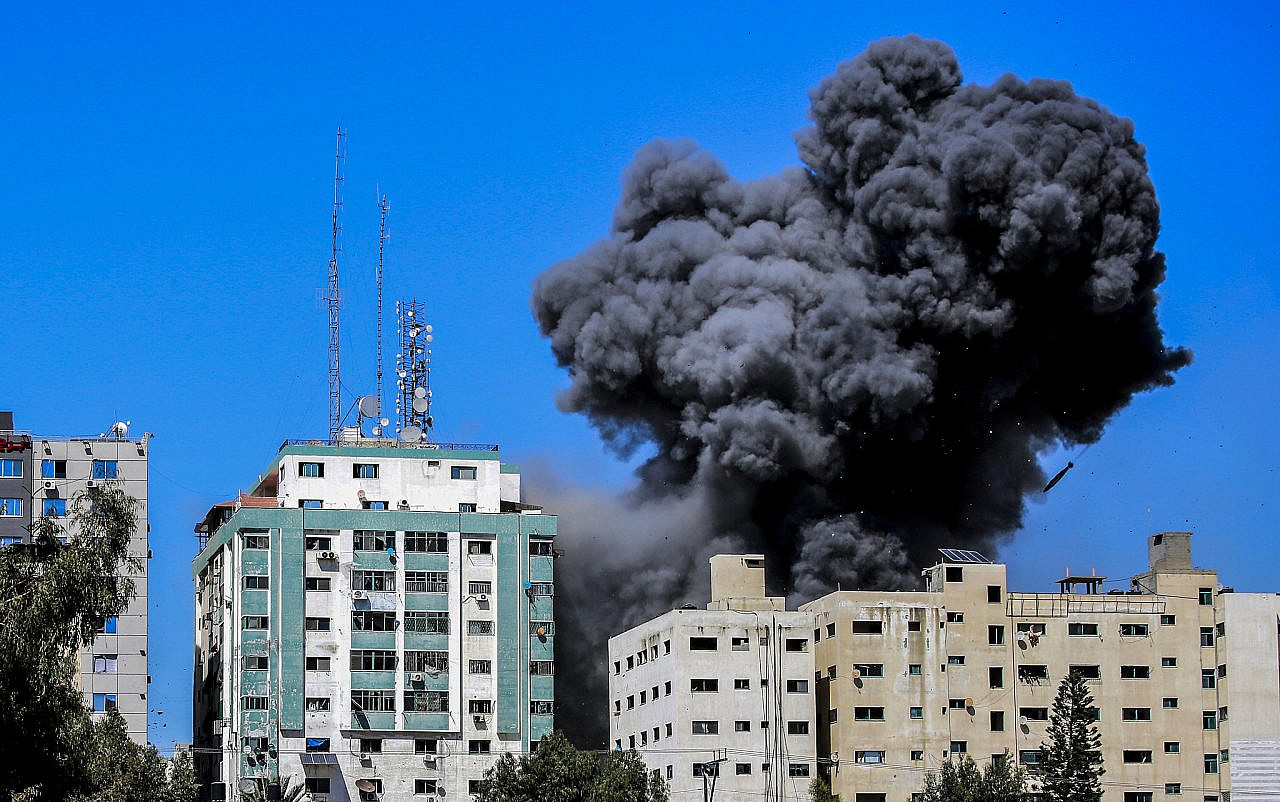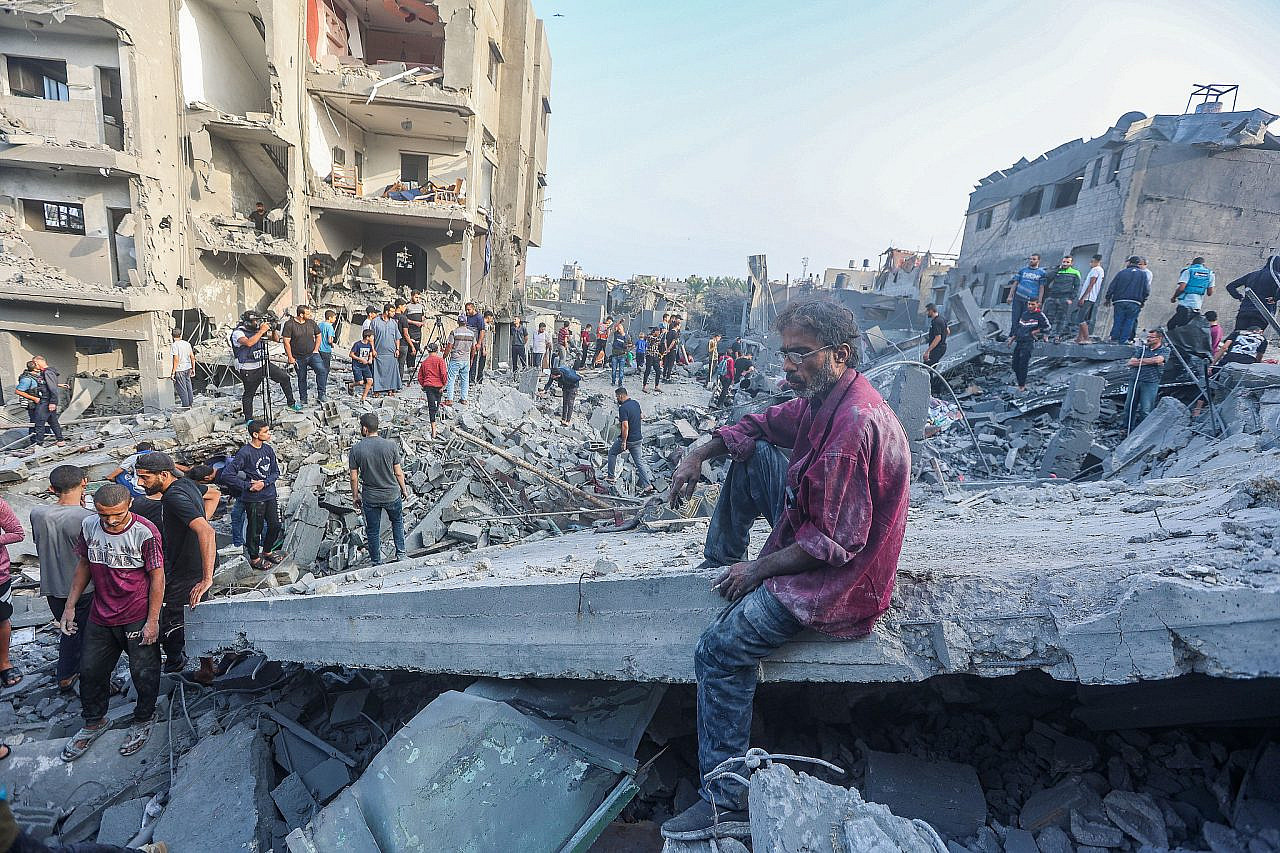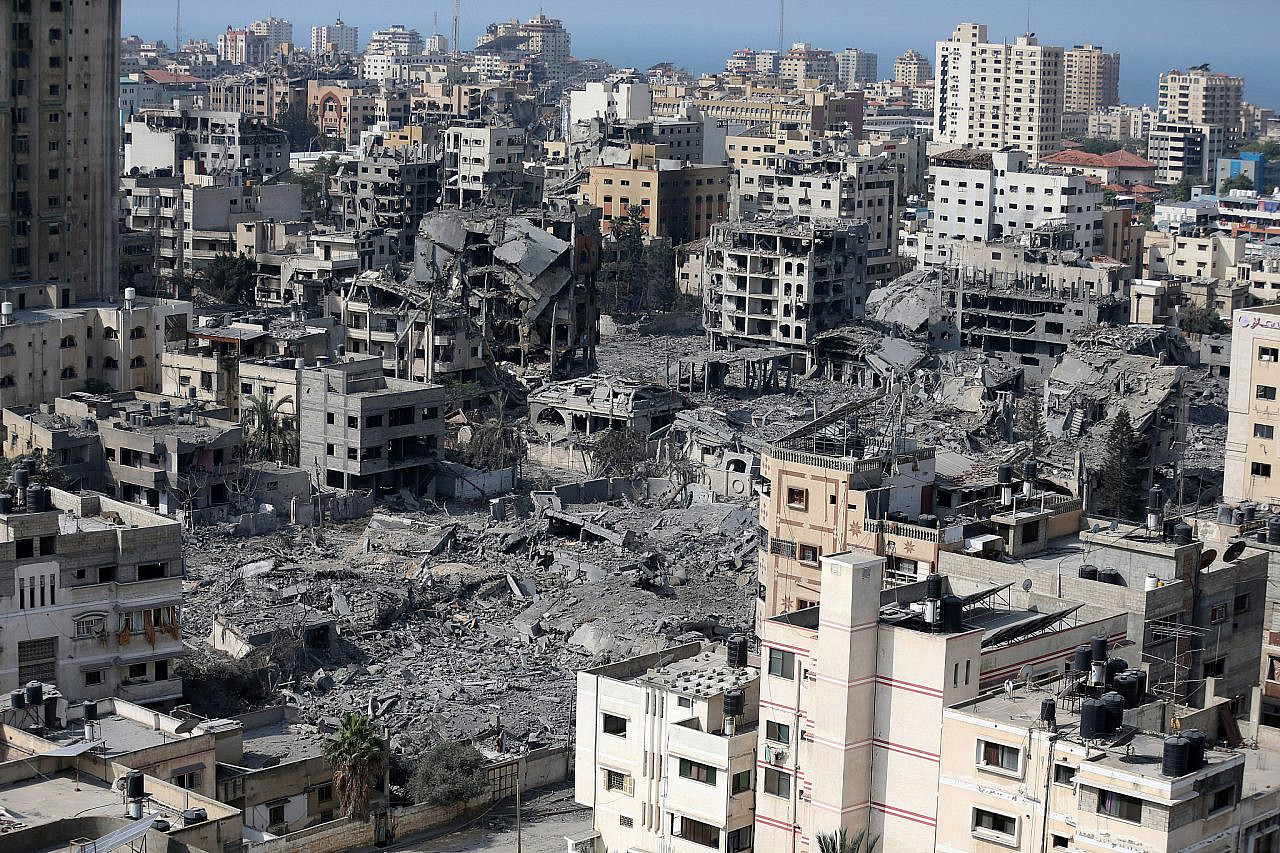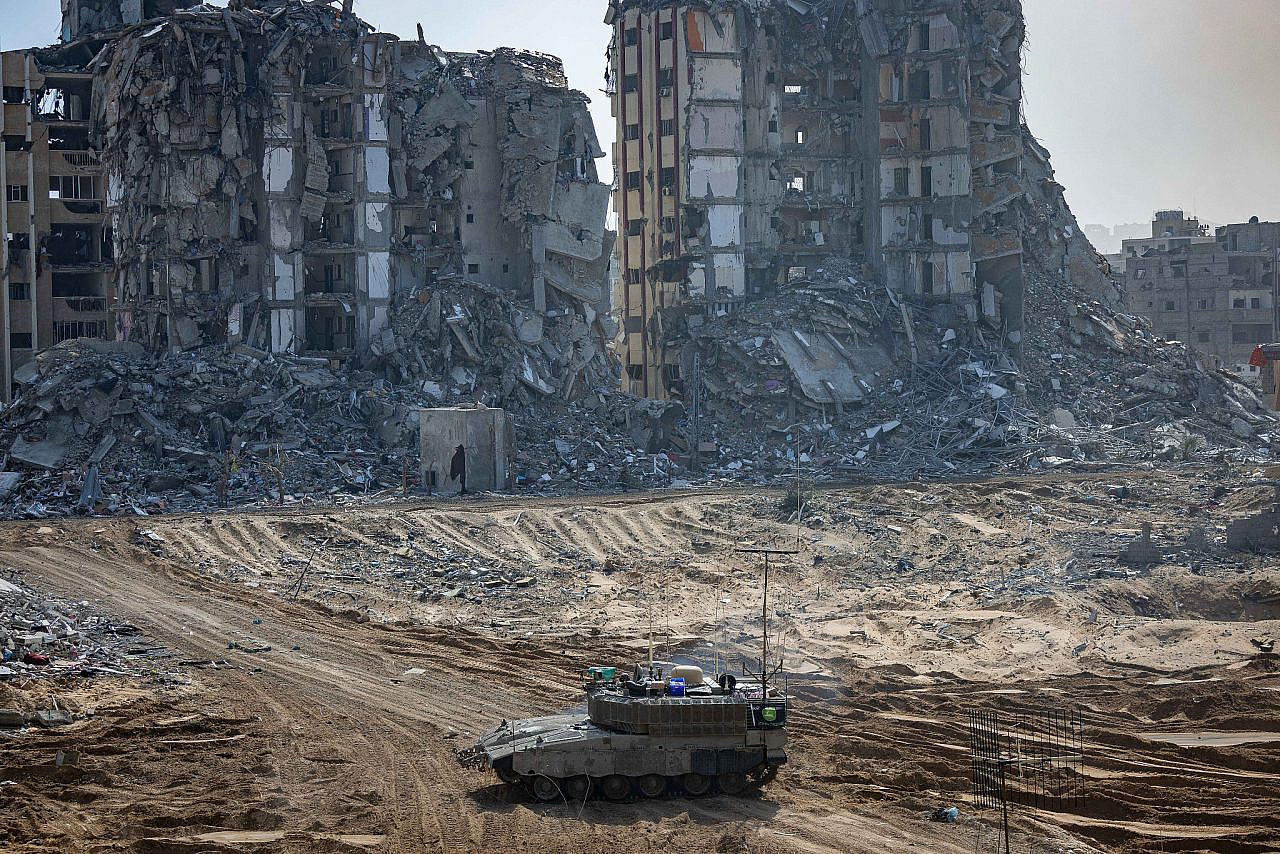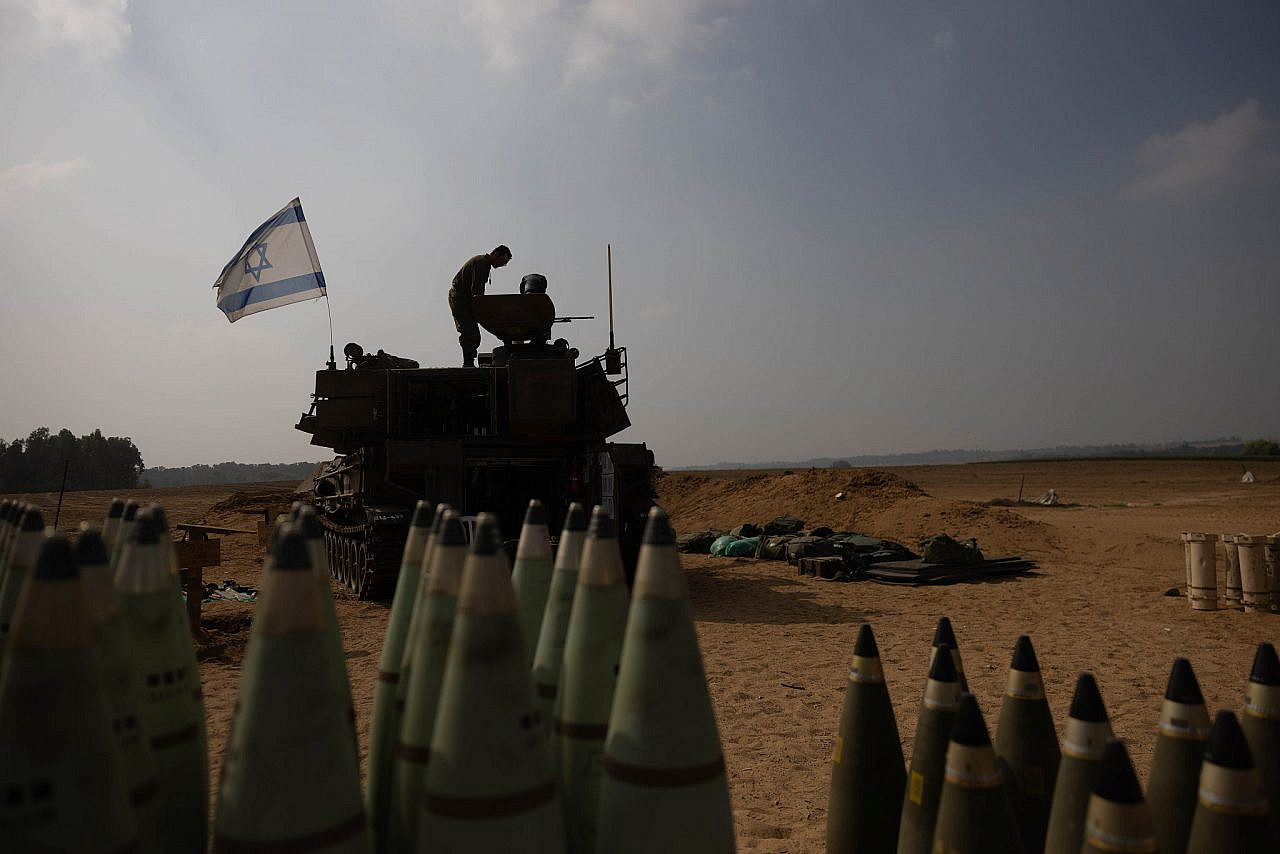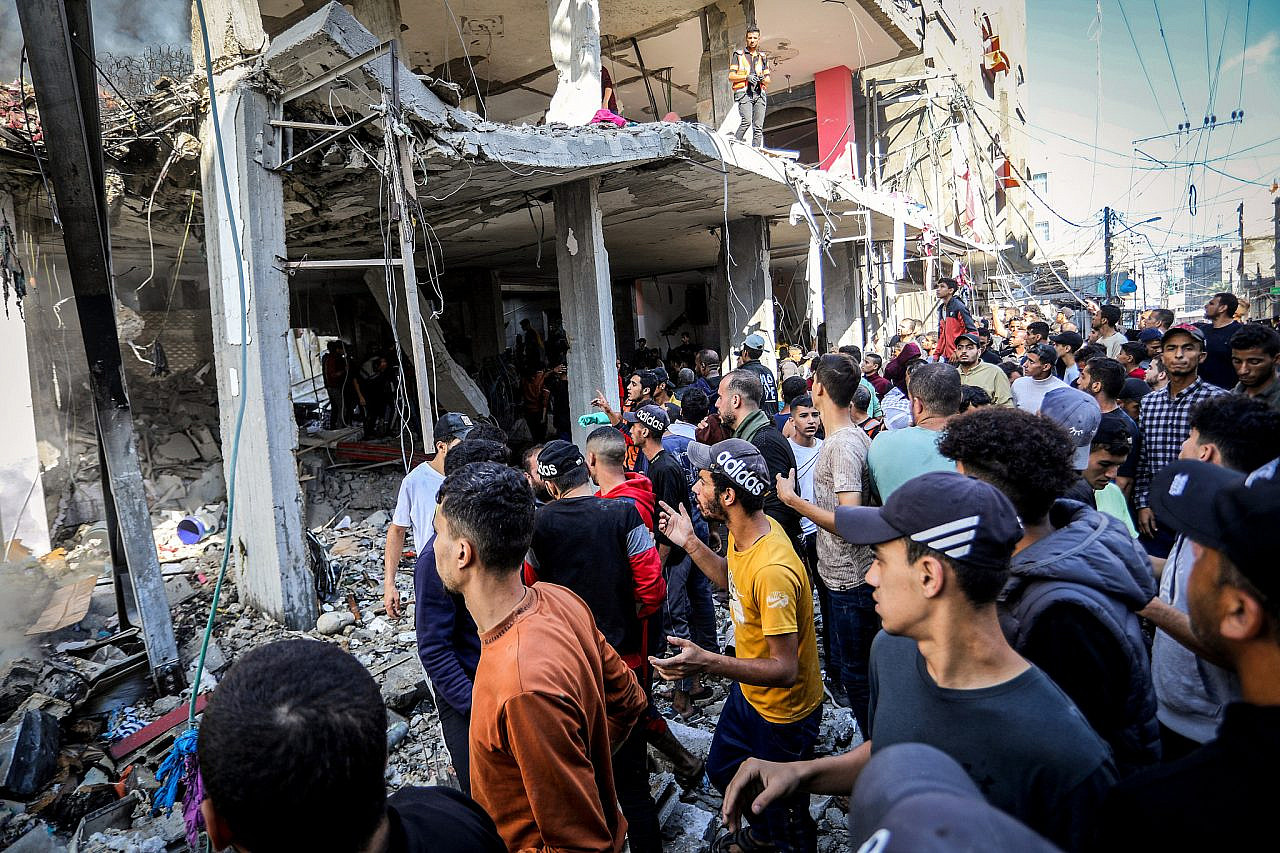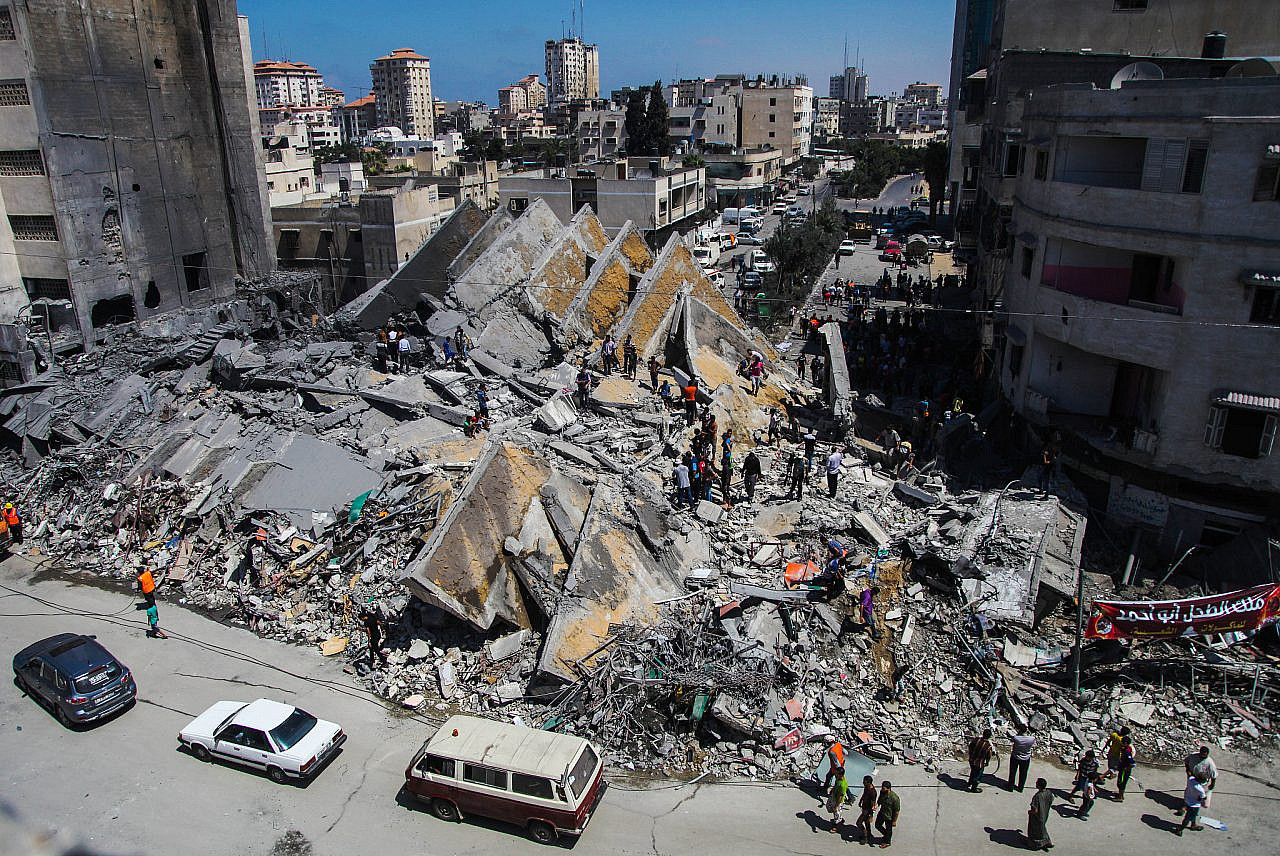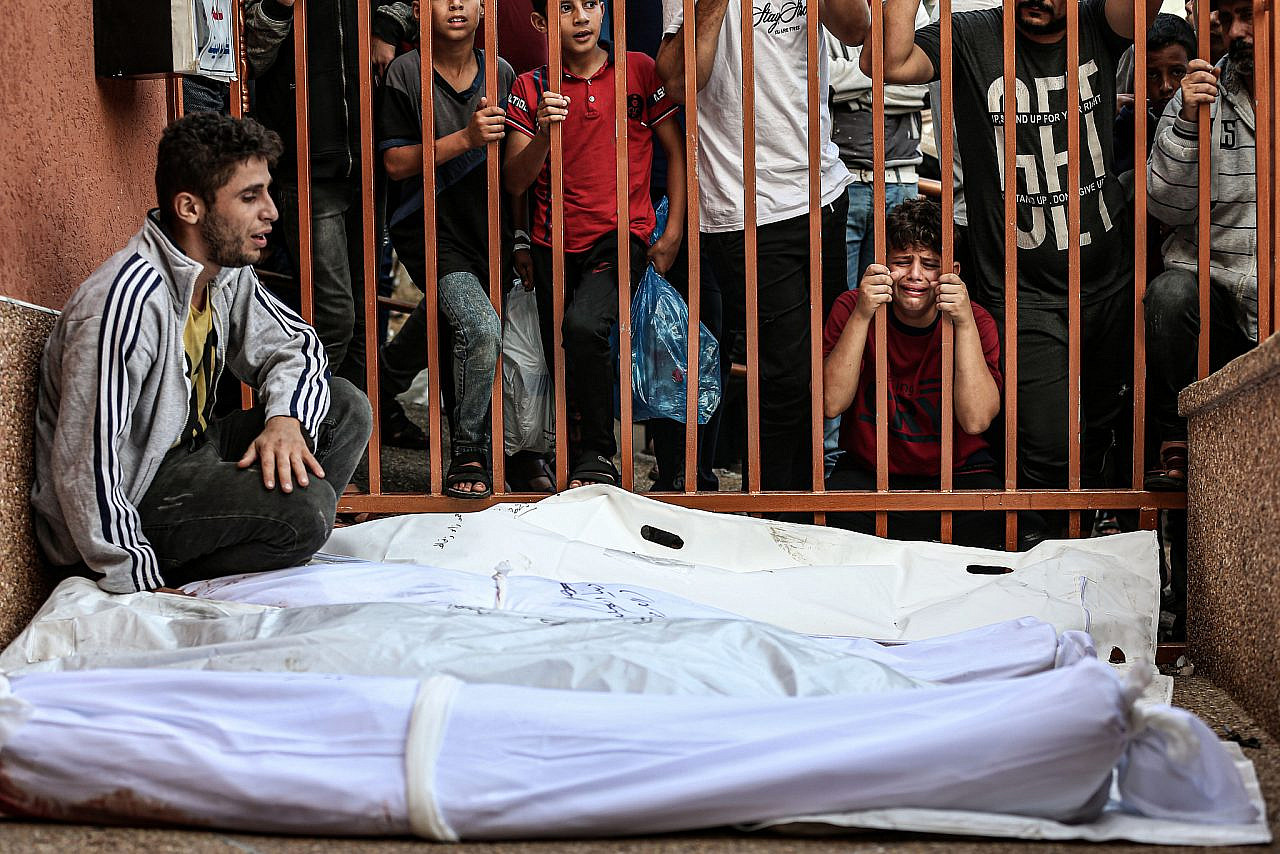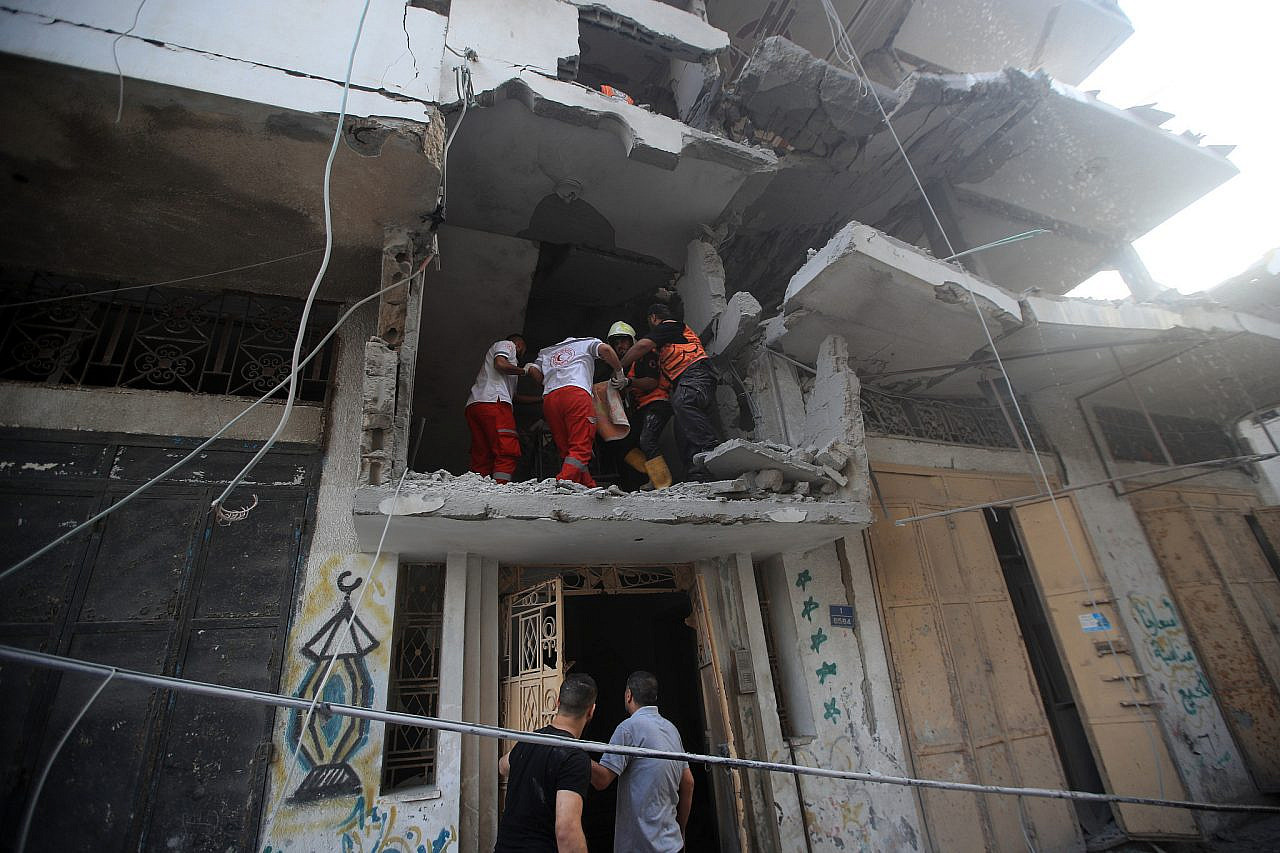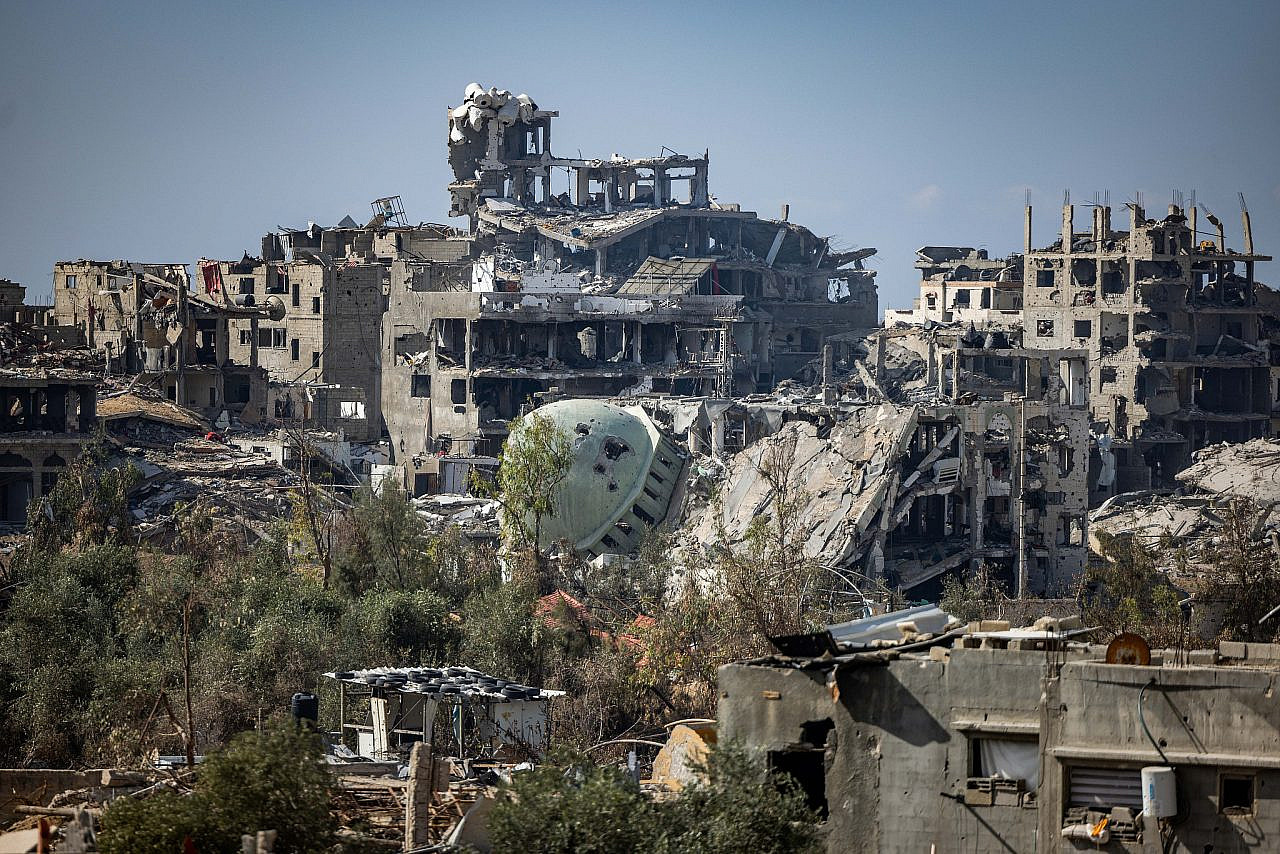‘A Mass Assassination Factory’: Inside Israel’s Calculated Bombing of Gaza
PALESTINE - ISRAEL, 4 Dec 2023
Yuval Abraham | +972 Magazine - TRANSCEND Media Service
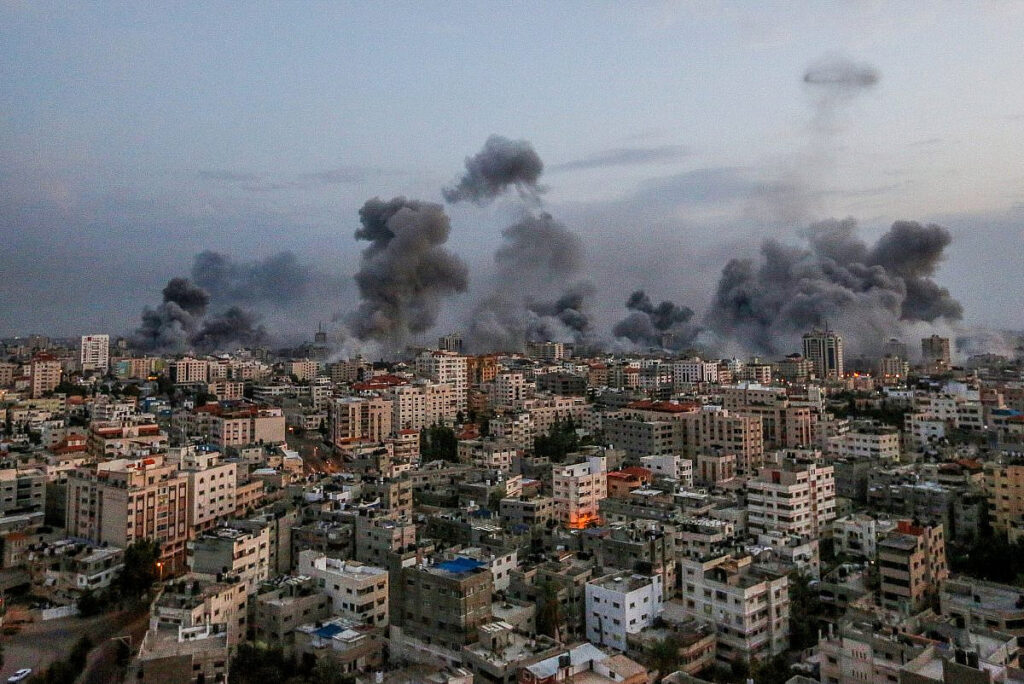
Smoke rises after Israeli airstrikes in several location in the Gaza Strip, 9 Oct 2023.
(Atia Mohammed/Flash90)
Permissive airstrikes on non-military targets and the use of an artificial intelligence system have enabled the Israeli army to carry out its deadliest assault on Gaza, investigation reveals.
30 Nov 2023 – The Israeli army’s expanded authorization for bombing non-military targets, the loosening of constraints regarding expected civilian casualties, and the use of an artificial intelligence system to generate more potential targets than ever before, appear to have contributed to the destructive nature of the initial stages of Israel’s current war on the Gaza Strip, an investigation by +972 Magazine and Local Call reveals. These factors, as described by current and former Israeli intelligence members, have likely played a role in producing what has been one of the deadliest military campaigns against Palestinians since the Nakba of 1948.
The investigation by +972 and Local Call is based on conversations with seven current and former members of Israel’s intelligence community — including military intelligence and air force personnel who were involved in Israeli operations in the besieged Strip — in addition to Palestinian testimonies, data, and documentation from the Gaza Strip, and official statements by the IDF Spokesperson and other Israeli state institutions.
Compared to previous Israeli assaults on Gaza, the current war — which Israel has named “Operation Iron Swords,” and which began in the wake of the Hamas-led assault on southern Israel on October 7 — has seen the army significantly expand its bombing of targets that are not distinctly military in nature. These include private residences as well as public buildings, infrastructure, and high-rise blocks, which sources say the army defines as “power targets” (“matarot otzem”).
The bombing of power targets, according to intelligence sources who had first-hand experience with its application in Gaza in the past, is mainly intended to harm Palestinian civil society: to “create a shock” that, among other things, will reverberate powerfully and “lead civilians to put pressure on Hamas,” as one source put it.
Several of the sources, who spoke to +972 and Local Call on the condition of anonymity, confirmed that the Israeli army has files on the vast majority of potential targets in Gaza — including homes — which stipulate the number of civilians who are likely to be killed in an attack on a particular target. This number is calculated and known in advance to the army’s intelligence units, who also know shortly before carrying out an attack roughly how many civilians are certain to be killed.
In one case discussed by the sources, the Israeli military command knowingly approved the killing of hundreds of Palestinian civilians in an attempt to assassinate a single top Hamas military commander. “The numbers increased from dozens of civilian deaths [permitted] as collateral damage as part of an attack on a senior official in previous operations, to hundreds of civilian deaths as collateral damage,” said one source.
“Nothing happens by accident,” said another source. “When a 3-year-old girl is killed in a home in Gaza, it’s because someone in the army decided it wasn’t a big deal for her to be killed — that it was a price worth paying in order to hit [another] target. We are not Hamas. These are not random rockets. Everything is intentional. We know exactly how much collateral damage there is in every home.”
According to the investigation, another reason for the large number of targets, and the extensive harm to civilian life in Gaza, is the widespread use of a system called “Habsora” (“The Gospel”), which is largely built on artificial intelligence and can “generate” targets almost automatically at a rate that far exceeds what was previously possible. This AI system, as described by a former intelligence officer, essentially facilitates a “mass assassination factory.”
According to the sources, the increasing use of AI-based systems like Habsora allows the army to carry out strikes on residential homes where a single Hamas member lives on a massive scale, even those who are junior Hamas operatives. Yet testimonies of Palestinians in Gaza suggest that since October 7, the army has also attacked many private residences where there was no known or apparent member of Hamas or any other militant group residing. Such strikes, sources confirmed to +972 and Local Call, can knowingly kill entire families in the process.
In the majority of cases, the sources added, military activity is not conducted from these targeted homes. “I remember thinking that it was like if [Palestinian militants] would bomb all the private residences of our families when [Israeli soldiers] go back to sleep at home on the weekend,” one source, who was critical of this practice, recalled.
Another source said that a senior intelligence officer told his officers after October 7 that the goal was to “kill as many Hamas operatives as possible,” for which the criteria around harming Palestinian civilians were significantly relaxed. As such, there are “cases in which we shell based on a wide cellular pinpointing of where the target is, killing civilians. This is often done to save time, instead of doing a little more work to get a more accurate pinpointing,” said the source.
The result of these policies is the staggering loss of human life in Gaza since October 7. Over 300 families have lost 10 or more family members in Israeli bombings in the past two months — a number that is 15 times higher than the figure from what was previously Israel’s deadliest war on Gaza, in 2014. At the time of writing, around 15,000 Palestinians have been reported killed in the war, and counting.
“All of this is happening contrary to the protocol used by the IDF in the past,” a source explained. “There is a feeling that senior officials in the army are aware of their failure on October 7, and are busy with the question of how to provide the Israeli public with an image [of victory] that will salvage their reputation.”
‘An excuse to cause destruction’
Israel launched its assault on Gaza in the aftermath of the October 7 Hamas-led offensive on southern Israel. During that attack, under a hail of rocket fire, Palestinian militants massacred more than 840 civilians and killed 350 soldiers and security personnel, kidnapped around 240 people — civilians and soldiers — to Gaza, and committed widespread sexual violence, including rape, according to a report by the NGO Physicians for Human Rights Israel.
From the first moment after the October 7 attack, decisionmakers in Israel openly declared that the response would be of a completely different magnitude to previous military operations in Gaza, with the stated aim of totally eradicating Hamas. “The emphasis is on damage and not on accuracy,” said IDF Spokesperson Daniel Hagari on Oct. 9. The army swiftly translated those declarations into actions.
According to the sources who spoke to +972 and Local Call, the targets in Gaza that have been struck by Israeli aircraft can be divided roughly into four categories. The first is “tactical targets,” which include standard military targets such as armed militant cells, weapon warehouses, rocket launchers, anti-tank missile launchers, launch pits, mortar bombs, military headquarters, observation posts, and so on.
The second is “underground targets” — mainly tunnels that Hamas has dug under Gaza’s neighborhoods, including under civilian homes. Aerial strikes on these targets could lead to the collapse of the homes above or near the tunnels.
The third is “power targets,” which includes high-rises and residential towers in the heart of cities, and public buildings such as universities, banks, and government offices. The idea behind hitting such targets, say three intelligence sources who were involved in planning or conducting strikes on power targets in the past, is that a deliberate attack on Palestinian society will exert “civil pressure” on Hamas.
The final category consists of “family homes” or “operatives’ homes.” The stated purpose of these attacks is to destroy private residences in order to assassinate a single resident suspected of being a Hamas or Islamic Jihad operative. However, in the current war, Palestinian testimonies assert that some of the families that were killed did not include any operatives from these organizations.
In the early stages of the current war, the Israeli army appears to have given particular attention to the third and fourth categories of targets. According to statements on Oct. 11 by the IDF Spokesperson, during the first five days of fighting, half of the targets bombed — 1,329 out of a total 2,687 — were deemed power targets.
“We are asked to look for high-rise buildings with half a floor that can be attributed to Hamas,” said one source who took part in previous Israeli offensives in Gaza. “Sometimes it is a militant group’s spokesperson’s office, or a point where operatives meet. I understood that the floor is an excuse that allows the army to cause a lot of destruction in Gaza. That is what they told us.
“If they would tell the whole world that the [Islamic Jihad] offices on the 10th floor are not important as a target, but that its existence is a justification to bring down the entire high-rise with the aim of pressuring civilian families who live in it in order to put pressure on terrorist organizations, this would itself be seen as terrorism. So they do not say it,” the source added.
Various sources who served in IDF intelligence units said that at least until the current war, army protocols allowed for attacking power targets only when the buildings were empty of residents at the time of the strike. However, testimonies and videos from Gaza suggest that since October 7, some of these targets have been attacked without prior notice being given to their occupants, killing entire families as a result.
The wide-scale targeting of residential homes can be derived from public and official data. According to the Government Media Office in Gaza — which has been providing death tolls since the Gaza Health Ministry stopped doing so on Nov. 11 due to the collapse of health services in the Strip — by the time the temporary ceasefire took hold on Nov. 23, Israel had killed 14,800 Palestinians in Gaza; approximately 6,000 of them were children and 4,000 were women, who together constitute more than 67 percent of the total. The figures provided by the Health Ministry and the Government Media Office — both of which fall under the auspices of the Hamas government — do not deviate significantly from Israeli estimates.
The Gaza Health Ministry, furthermore, does not specify how many of the dead belonged to the military wings of Hamas or Islamic Jihad. The Israeli army estimates that it has killed between 1,000 and 3,000 armed Palestinian militants. According to media reports in Israel, some of the dead militants are buried under the rubble or inside Hamas’ underground tunnel system, and therefore were not tallied in official counts.
UN data for the period up until Nov. 11, by which time Israel had killed 11,078 Palestinians in Gaza, states that at least 312 families have lost 10 or more people in the current Israeli attack; for the sake of comparison, during “Operation Protective Edge” in 2014, 20 families in Gaza lost 10 or more people. At least 189 families have lost between six and nine people according to the UN data, while 549 families have lost between two and five people. No updated breakdowns have yet been given for the casualty figures published since Nov. 11.
The massive attacks on power targets and private residences came at the same time as the Israeli army, on Oct. 13, called on the 1.1 million residents of the northern Gaza Strip — most of them residing in Gaza City — to leave their homes and move to the south of the Strip. By that date, a record number of power targets had already been bombed, and more than 1,000 Palestinians had already been killed, including hundreds of children.
In total, according to the UN, 1.7 million Palestinians, the vast majority of the Strip’s population, have been displaced within Gaza since October 7. The army claimed that the demand to evacuate the Strip’s north was intended to protect civilian lives. Palestinians, however, see this mass displacement as part of a “new Nakba” — an attempt to ethnically cleanse part or all of the territory.
‘They knocked down a high-rise for the sake of it’
According to the Israeli army, during the first five days of fighting it dropped 6,000 bombs on the Strip, with a total weight of about 4,000 tons. Media outlets reported that the army had wiped out entire neighborhoods; according to the Gaza-based Al Mezan Center for Human Rights, these attacks led to “the complete destruction of residential neighborhoods, the destruction of infrastructure, and the mass killing of residents.”
As documented by Al Mezan and numerous images coming out of Gaza, Israel bombed the Islamic University of Gaza, the Palestinian Bar Association, a UN building for an educational program for outstanding students, a building belonging to the Palestine Telecommunications Company, the Ministry of National Economy, the Ministry of Culture, roads, and dozens of high-rise buildings and homes — especially in Gaza’s northern neighborhoods.
On the fifth day of fighting, the IDF Spokesperson distributed to military reporters in Israel “before and after” satellite images of neighborhoods in the northern Strip, such as Shuja’iyya and Al-Furqan (nicknamed after a mosque in the area) in Gaza City, which showed dozens of destroyed homes and buildings. The Israeli army said that it had struck 182 power targets in Shuja’iyya and 312 power targets in Al-Furqan.
The Chief of Staff of the Israeli Air Force, Omer Tishler, told military reporters that all of these attacks had a legitimate military target, but also that entire neighborhoods were attacked “on a large scale and not in a surgical manner.” Noting that half of the military targets up until Oct. 11 were power targets, the IDF Spokesperson said that “neighborhoods that serve as terror nests for Hamas” were attacked and that damage was caused to “operational headquarters,” “operational assets,” and “assets used by terrorist organizations inside residential buildings.” On Oct. 12, the Israeli army announced it had killed three “senior Hamas members” — two of whom were part of the group’s political wing.
Yet despite the unbridled Israeli bombardment, the damage to Hamas’ military infrastructure in northern Gaza during the first days of the war appears to have been very minimal. Indeed, intelligence sources told +972 and Local Call that military targets that were part of power targets have previously been used many times as a fig leaf for harming the civilian population. “Hamas is everywhere in Gaza; there is no building that does not have something of Hamas in it, so if you want to find a way to turn a high-rise into a target, you will be able to do so,” said one former intelligence official.
“They will never just hit a high-rise that does not have something we can define as a military target,” said another intelligence source, who carried out previous strikes against power targets. “There will always be a floor in the high-rise [associated with Hamas]. But for the most part, when it comes to power targets, it is clear that the target doesn’t have military value that justifies an attack that would bring down the entire empty building in the middle of a city, with the help of six planes and bombs weighing several tons.”
Indeed, according to sources who were involved in the compiling of power targets in previous wars, although the target file usually contains some kind of alleged association with Hamas or other militant groups, striking the target functions primarily as a “means that allows damage to civil society.” The sources understood, some explicitly and some implicitly, that damage to civilians is the real purpose of these attacks.
In May 2021, for example, Israel was heavily criticized for bombing the Al-Jalaa Tower, which housed prominent international media outlets such as Al Jazeera, AP, and AFP. The army claimed that the building was a Hamas military target; sources have told +972 and Local Call that it was in fact a power target.
“The perception is that it really hurts Hamas when high-rise buildings are taken down, because it creates a public reaction in the Gaza Strip and scares the population,” said one of the sources. “They wanted to give the citizens of Gaza the feeling that Hamas is not in control of the situation. Sometimes they toppled buildings and sometimes postal service and government buildings.”
Although it is unprecedented for the Israeli army to attack more than 1,000 power targets in five days, the idea of causing mass devastation to civilian areas for strategic purposes was formulated in previous military operations in Gaza, honed by the so-called “Dahiya Doctrine” from the Second Lebanon War of 2006.
According to the doctrine — developed by former IDF Chief of Staff Gadi Eizenkot, who is now a Knesset member and part of the current war cabinet — in a war against guerrilla groups such as Hamas or Hezbollah, Israel must use disproportionate and overwhelming force while targeting civilian and government infrastructure in order to establish deterrence and force the civilian population to pressure the groups to end their attacks. The concept of “power targets” seems to have emanated from this same logic.
The first time the Israeli army publicly defined power targets in Gaza was at the end of Operation Protective Edge in 2014. The army bombed four buildings during the last four days of the war — three residential multi-story buildings in Gaza City, and a high-rise in Rafah. The security establishment explained at the time that the attacks were intended to convey to the Palestinians of Gaza that “nothing is immune anymore,” and to put pressure on Hamas to agree to a ceasefire. “The evidence we collected shows that the massive destruction [of the buildings] was carried out deliberately, and without any military justification,” stated an Amnesty report in late 2014.
In another violent escalation that began in November 2018, the army once again attacked power targets. That time, Israel bombed high-rises, shopping centers, and the building of the Hamas-affiliated Al-Aqsa TV station. “Attacking power targets produces a very significant effect on the other side,” one Air Force officer stated at the time. “We did it without killing anyone and we made sure that the building and its surroundings were evacuated.”
Previous operations have also shown how striking these targets is meant not only to harm Palestinian morale, but also to raise the morale inside Israel. Haaretz revealed that during Operation Guardian of the Walls in 2021, the IDF Spokesperson’s Unit conducted a psy-op against Israeli citizens in order to boost awareness of the IDF’s operations in Gaza and the damage they caused to Palestinians. Soldiers, who used fake social media accounts to conceal the campaign’s origin, uploaded images and clips of the army’s strikes in Gaza to Twitter, Facebook, Instagram, and TikTok in order to demonstrate the army’s prowess to the Israeli public.
During the 2021 assault, Israel struck nine targets that were defined as power targets — all of them high-rise buildings. “The goal was to collapse the high-rises in order to put pressure on Hamas, and also so that the [Israeli] public would see a victory image,” one security source told +972 and Local Call.
However, the source continued, “it didn’t work. As someone who has followed Hamas, I heard firsthand how much they did not care about the civilians and the buildings that were taken down. Sometimes the army found something in a high-rise building that was related to Hamas, but it was also possible to hit that specific target with more accurate weaponry. The bottom line is that they knocked down a high-rise for the sake of knocking down a high-rise.”
‘Everyone was looking for their children in these piles’
Not only has the current war seen Israel attack an unprecedented number of power targets, it has also seen the army abandon prior policies that aimed at avoiding harm to civilians. Whereas previously the army’s official procedure was that it was possible to attack power targets only after all civilians had been evacuated from them, testimonies from Palestinian residents in Gaza indicate that, since October 7, Israel has attacked high-rises with their residents still inside, or without having taken significant steps to evacuate them, leading to many civilian deaths.
Such attacks very often result in the killing of entire families, as experienced in previous offensives; according to an investigation by AP conducted after the 2014 war, about 89 percent of those killed in the aerial bombings of family homes were unarmed residents, and most of them were children and women.
Tishler, the air force chief of staff, confirmed a shift in policy, telling reporters that the army’s “roof knocking” policy — whereby it would fire a small initial strike on the roof of a building to warn residents that it is about to be struck — is no longer in use “where there is an enemy.” Roof knocking, Tishler said, is “a term that is relevant to rounds [of fighting] and not to war.”
The sources who have previously worked on power targets said that the brazen strategy of the current war could be a dangerous development, explaining that attacking power targets was originally intended to “shock” Gaza but not necessarily to kill large numbers of civilians. “The targets were designed with the assumption that high-rises would be evacuated of people, so when we were working on [compiling the targets], there was no concern whatsoever regarding how many civilians would be harmed; the assumption was that the number would always be zero,” said one source with deep knowledge of the tactic.
“This would mean there would be a total evacuation [of the targeted buildings], which takes two to three hours, during which the residents are called [by phone to evacuate], warning missiles are fired, and we also crosscheck with drone footage that people are indeed leaving the high-rise,” the source added.
However, evidence from Gaza suggests that some high-rises — which we assume to have been power targets — were toppled without prior warning. +972 and Local Call located at least two cases during the current war in which entire residential high-rises were bombed and collapsed without warning, and one case in which, according to the evidence, a high-rise building collapsed on civilians who were inside.
On Oct. 10, Israel bombed the Babel Building in Gaza, according to the testimony of Bilal Abu Hatzira, who rescued bodies from the ruins that night. Ten people were killed in the attack on the building, including three journalists.
On Oct. 25, the 12-story Al-Taj residential building in Gaza City was bombed to the ground, killing the families living inside it without warning. About 120 people were buried under the ruins of their apartments, according to the testimonies of residents. Yousef Amar Sharaf, a resident of Al-Taj, wrote on X that 37 of his family members who lived in the building were killed in the attack: “My dear father and mother, my beloved wife, my sons, and most of my brothers and their families.” Residents stated that a lot of bombs were dropped, damaging and destroying apartments in nearby buildings too.
Six days later, on Oct. 31, the eight-story Al-Mohandseen residential building was bombed without warning. Between 30 and 45 bodies were reportedly recovered from the ruins on the first day. One baby was found alive, without his parents. Journalists estimated that over 150 people were killed in the attack, as many remained buried under the rubble.
The building used to stand in Nuseirat Refugee Camp, south of Wadi Gaza — in the supposed “safe zone” to which Israel directed the Palestinians who fled their homes in northern and central Gaza — and therefore served as temporary shelter for the displaced, according to testimonies.
According to an investigation by Amnesty International, on Oct. 9, Israel shelled at least three multi-story buildings, as well as an open flea market on a crowded street in the Jabaliya Refugee Camp, killing at least 69 people. “The bodies were burned … I didn’t want to look, I was scared of looking at Imad’s face,” said the father of a child who was killed. “The bodies were scattered on the floor. Everyone was looking for their children in these piles. I recognized my son only by his trousers. I wanted to bury him immediately, so I carried my son and got him out.”
According to Amnesty’s investigation, the army said that the attack on the market area was aimed at a mosque “where there were Hamas operatives.” However, according to the same investigation, satellite images do not show a mosque in the vicinity.
The IDF Spokesperson did not address +972’s and Local Call’s queries about specific attacks, but stated more generally that “the IDF provided warnings before attacks in various ways, and when the circumstances allowed it, also delivered individual warnings through phone calls to people who were at or near the targets (there were more from 25,000 live conversations during the war, alongside millions of recorded conversations, text messages and leaflets dropped from the air for the purpose of warning the population). In general, the IDF works to reduce harm to civilians as part of the attacks as much as possible, despite the challenge of fighting a terrorist organization that uses the citizens of Gaza as human shields.”
‘The machine produced 100 targets in one day’
According to the IDF Spokesperson, by Nov. 10, during the first 35 days of fighting, Israel attacked a total of 15,000 targets in Gaza. Based on multiple sources, this is a very high figure compared to the four previous major operations in the Strip. During Guardian of the Walls in 2021, Israel attacked 1,500 targets in 11 days. In Protective Edge in 2014, which lasted 51 days, Israel struck between 5,266 and 6,231 targets. During Pillar of Defense in 2012, about 1,500 targets were attacked over eight days. In Cast Lead” in 2008, Israel struck 3,400 targets in 22 days.
Intelligence sources who served in the previous operations also told +972 and Local Call that, for 10 days in 2021 and three weeks in 2014, an attack rate of 100 to 200 targets per day led to a situation in which the Israeli Air Force had no targets of military value left. Why, then, after nearly two months, has the Israeli army not yet run out of targets in the current war?
The answer may lie in a statement from the IDF Spokesperson on Nov. 2, according to which it is using the AI system Habsora (“The Gospel”), which the spokesperson says “enables the use of automatic tools to produce targets at a fast pace, and works by improving accurate and high-quality intelligence material according to [operational] needs.”
In the statement, a senior intelligence official is quoted as saying that thanks to Habsora, targets are created for precision strikes “while causing great damage to the enemy and minimal damage to non-combatants. Hamas operatives are not immune — no matter where they hide.”
According to intelligence sources, Habsora generates, among other things, automatic recommendations for attacking private residences where people suspected of being Hamas or Islamic Jihad operatives live. Israel then carries out large-scale assassination operations through the heavy shelling of these residential homes.
Habsora, explained one of the sources, processes enormous amounts of data that “tens of thousands of intelligence officers could not process,” and recommends bombing sites in real time. Because most senior Hamas officials head into underground tunnels with the start of any military operation, the sources say, the use of a system like Habsora makes it possible to locate and attack the homes of relatively junior operatives.
One former intelligence officer explained that the Habsora system enables the army to run a “mass assassination factory,” in which the “emphasis is on quantity and not on quality.” A human eye “will go over the targets before each attack, but it need not spend a lot of time on them.” Since Israel estimates that there are approximately 30,000 Hamas members in Gaza, and they are all marked for death, the number of potential targets is enormous.
In 2019, the Israeli army created a new center aimed at using AI to accelerate target generation. “The Targets Administrative Division is a unit that includes hundreds of officers and soldiers, and is based on AI capabilities,” said former IDF Chief of Staff Aviv Kochavi in an in-depth interview with Ynet earlier this year.
“This is a machine that, with the help of AI, processes a lot of data better and faster than any human, and translates it into targets for attack,” Kochavi went on. “The result was that in Operation Guardian of the Walls [in 2021], from the moment this machine was activated, it generated 100 new targets every day. You see, in the past there were times in Gaza when we would create 50 targets per year. And here the machine produced 100 targets in one day.”
“We prepare the targets automatically and work according to a checklist,” one of the sources who worked in the new Targets Administrative Division told +972 and Local Call. “It really is like a factory. We work quickly and there is no time to delve deep into the target. The view is that we are judged according to how many targets we manage to generate.”
A senior military official in charge of the target bank told the Jerusalem Post earlier this year that, thanks to the army’s AI systems, for the first time the military can generate new targets at a faster rate than it attacks. Another source said the drive to automatically generate large numbers of targets is a realization of the Dahiya Doctrine.
Automated systems like Habsora have thus greatly facilitated the work of Israeli intelligence officers in making decisions during military operations, including calculating potential casualties. Five different sources confirmed that the number of civilians who may be killed in attacks on private residences is known in advance to Israeli intelligence, and appears clearly in the target file under the category of “collateral damage.”
According to these sources, there are degrees of collateral damage, according to which the army determines whether it is possible to attack a target inside a private residence. “When the general directive becomes ‘Collateral Damage 5,’ that means we are authorized to strike all targets that will kill five or less civilians — we can act on all target files that are five or less,” said one of the sources.
“In the past, we did not regularly mark the homes of junior Hamas members for bombing,” said a security official who participated in attacking targets during previous operations. “In my time, if the house I was working on was marked Collateral Damage 5, it would not always be approved [for attack].” Such approval, he said, would only be received if a senior Hamas commander was known to be living in the home.
“To my understanding, today they can mark all the houses of [any Hamas military operative regardless of rank],” the source continued. “That is a lot of houses. Hamas members who don’t really matter for anything live in homes across Gaza. So they mark the home and bomb the house and kill everyone there.”
A concerted policy to bomb family homes
On Oct. 22, the Israeli Air Force bombed the home of the Palestinian journalist Ahmed Alnaouq in the city of Deir al-Balah. Ahmed is a close friend and colleague of mine; four years ago, we founded a Hebrew Facebook page called “Across the Wall,” with the aim of bringing Palestinian voices from Gaza to the Israeli public.
The strike on Oct. 22 collapsed blocks of concrete onto Ahmed’s entire family, killing his father, brothers, sisters, and all of their children, including babies. Only his 12-year-old niece, Malak, survived and remained in a critical condition, her body covered in burns. A few days later, Malak died.
Twenty-one members of Ahmed’s family were killed in total, buried under their home. None of them were militants. The youngest was 2 years old; the oldest, his father, was 75. Ahmed, who is currently living in the UK, is now alone out of his entire family.
Ahmed’s family WhatsApp group is titled “Better Together.” The last message that appears there was sent by him, a little after midnight on the night he lost his family. “Someone let me know that everything is fine,” he wrote. No one answered. He fell asleep, but woke up in a panic at 4 a.m. Drenched in sweat, he checked his phone again. Silence. Then he received a message from a friend with the terrible news.
Ahmed’s case is common in Gaza these days. In interviews to the press, heads of Gaza hospitals have been echoing the same description: families enter hospitals as a succession of corpses, a child followed by his father followed by his grandfather. The bodies are all covered in dirt and blood.
According to former Israeli intelligence officers, in many cases in which a private residence is bombed, the goal is the “assassination of Hamas or Jihad operatives,” and such targets are attacked when the operative enters the home. Intelligence researchers know if the operative’s family members or neighbors may also die in an attack, and they know how to calculate how many of them may die. Each of the sources said that these are private homes, where in the majority of cases, no military activity is carried out.
+972 and Local Call do not have data regarding the number of military operatives who were indeed killed or wounded by aerial strikes on private residences in the current war, but there is ample evidence that, in many cases, none were military or political operatives belonging to Hamas or Islamic Jihad.
On Oct. 10, the Israeli Air Force bombed an apartment building in Gaza’s Sheikh Radwan neighborhood, killing 40 people, most of them women and children. In one of the shocking videos taken following the attack, people are seen screaming, holding what appears to be a doll pulled from the ruins of the house, and passing it from hand to hand. When the camera zooms in, one can see that it is not a doll, but the body of a baby.
One of the residents said that 19 members of his family were killed in the strike. Another survivor wrote on Facebook that he only found his son’s shoulder in the rubble. Amnesty investigated the attack and discovered that a Hamas member lived on one of the upper floors of the building, but was not present at the time of the attack.
The bombing of family homes where Hamas or Islamic Jihad operatives supposedly live likely became a more concerted IDF policy during Operation Protective Edge in 2014. Back then, 606 Palestinians — about a quarter of the civilian deaths during the 51 days of fighting — were members of families whose homes were bombed. A UN report defined it in 2015 as both a potential war crime and “a new pattern” of action that “led to the death of entire families.”
In 2014, 93 babies were killed as a result of Israeli bombings of family homes, of which 13 were under 1 year old. A month ago, 286 babies aged 1 or under were already identified as having been killed in Gaza, according to a detailed ID list with the ages of victims published by the Gaza Health Ministry on Oct. 26. The number has since likely doubled or tripled.
However, in many cases, and especially during the current attacks on Gaza, the Israeli army has carried out attacks that struck private residences even when there is no known or clear military target. For example, according to the Committee to Protect Journalists, by Nov. 29, Israel had killed 50 Palestinian journalists in Gaza, some of them in their homes with their families.
Roshdi Sarraj, 31, a journalist from Gaza who was born in Britain, founded a media outlet in Gaza called “Ain Media.” On Oct. 22, an Israeli bomb struck his parents’ home where he was sleeping, killing him. The journalist Salam Mema similarly died under the ruins of her home after it was bombed; of her three young children, Hadi, 7, died, while Sham, 3, has not yet been found under the rubble. Two other journalists, Duaa Sharaf and Salma Makhaimer, were killed together with their children in their homes.
Israeli analysts have admitted that the military effectiveness of these kinds of disproportionate aerial attacks is limited. Two weeks after the start of the bombings in Gaza (and before the ground invasion) — after the bodies of 1,903 children, approximately 1,000 women, and 187 elderly men were counted in the Gaza Strip — Israeli commentator Avi Issacharoff tweeted: “As hard as it is to hear, on the 14th day of fighting, it does not appear that the military arm of Hamas has been significantly harmed. The most significant damage to the military leadership is the assassination of [Hamas commander] Ayman Nofal.”
‘Fighting human animals’
Hamas militants regularly operate out of an intricate network of tunnels built under large stretches of the Gaza Strip. These tunnels, as confirmed by the former Israeli intelligence officers we spoke to, also pass under homes and roads. Therefore, Israeli attempts to destroy them with aerial strikes are in many cases likely to lead to the killing of civilians. This may be another reason for the high number of Palestinian families wiped out in the current offensive.
The intelligence officers interviewed for this article said that the way Hamas designed the tunnel network in Gaza knowingly exploits the civilian population and infrastructure above ground. These claims were also the basis of the media campaign that Israel conducted vis-a-vis the attacks and raids on Al-Shifa Hospital and the tunnels that were discovered under it.
Israel has also attacked a large number of military targets: armed Hamas operatives, rocket launcher sites, snipers, anti-tank squads, military headquarters, bases, observation posts, and more. From the beginning of the ground invasion, aerial bombardment and heavy artillery fire have been used to provide backup to Israeli troops on the ground. Experts in international law say these targets are legitimate, as long as the strikes comply with the principle of proportionality.
In response to an enquiry from +972 and Local Call for this article, the IDF Spokesperson stated: “The IDF is committed to international law and acts according to it, and in doing so attacks military targets and does not attack civilians. The terrorist organization Hamas places its operatives and military assets in the heart of the civilian population. Hamas systematically uses the civilian population as a human shield, and conducts combat from civilian buildings, including sensitive sites such as hospitals, mosques, schools, and UN facilities.”
Intelligence sources who spoke to +972 and Local Call similarly claimed that in many cases Hamas “deliberately endangers the civilian population in Gaza and tries to forcefully prevent civilians from evacuating.” Two sources said that Hamas leaders “understand that Israeli harm to civilians gives them legitimacy in fighting.”
At the same time, while it’s hard to imagine now, the idea of dropping a one-ton bomb aimed at killing a Hamas operative yet ending up killing an entire family as “collateral damage” was not always so readily accepted by large swathes of Israeli society. In 2002, for example, the Israeli Air Force bombed the home of Salah Mustafa Muhammad Shehade, then the head of the Al-Qassam Brigades, Hamas’ military wing. The bomb killed him, his wife Eman, his 14-year-old daughter Laila, and 14 other civilians, including 11 children. The killing caused a public uproar in both Israel and the world, and Israel was accused of committing war crimes.
That criticism led to a decision by the Israeli army in 2003 to drop a smaller, quarter-ton bomb on a meeting of top Hamas officials — including the elusive leader of Al-Qassam Brigades, Mohammed Deif — taking place in a residential building in Gaza, despite the fear that it would not be powerful enough to kill them. In his book “To Know Hamas,” veteran Israeli journalist Shlomi Eldar wrote that the decision to use a relatively small bomb was due to the Shehade precedent, and the fear that a one-ton bomb would kill the civilians in the building as well. The attack failed, and the senior military wing officers fled the scene.
In December 2008, in the first major war that Israel waged against Hamas after it seized power in Gaza, Yoav Gallant, who at the time headed the IDF Southern Command, said that for the first time Israel was “hitting the family homes” of senior Hamas officials with the aim of destroying them, but not harming their families. Gallant emphasized that the homes were attacked after the families were warned by a “knock on the roof,” as well as by phone call, after it was clear that Hamas military activity was taking place inside the house.
After 2014’s Protective Edge, during which Israel began to systematically strike family homes from the air, human rights groups like B’Tselem collected testimonies from Palestinians who survived these attacks. The survivors said the homes collapsed in on themselves, glass shards cut the bodies of those inside, the debris “smells of blood,” and people were buried alive.
This deadly policy continues today — thanks in part to the use of destructive weaponry and sophisticated technology like Habsora, but also to a political and security establishment that has loosened the reins on Israel’s military machinery. Fifteen years after insisting that the army was taking pains to minimize civilian harm, Gallant, now Defense Minister, has clearly changed his tune. “We are fighting human animals and we act accordingly,” he said after October 7.
_________________________________________________
Yuval Abraham is a journalist and activist based in Jerusalem.
Join the BDS-BOYCOTT, DIVESTMENT, SANCTIONS campaign to protest the Israeli barbaric siege of Gaza, illegal occupation of the Palestine nation’s territory, the apartheid wall, its inhuman and degrading treatment of the Palestinian people, and the more than 7,000 Palestinian men, women, elderly and children arbitrarily locked up in Israeli prisons.
DON’T BUY PRODUCTS WHOSE BARCODE STARTS WITH 729, which indicates that it is produced in Israel. DO YOUR PART! MAKE A DIFFERENCE!
7 2 9: BOYCOTT FOR JUSTICE!
DISCLAIMER: The statements, views and opinions expressed in pieces republished here are solely those of the authors and do not necessarily represent those of TMS. In accordance with title 17 U.S.C. section 107, this material is distributed without profit to those who have expressed a prior interest in receiving the included information for research and educational purposes. TMS has no affiliation whatsoever with the originator of this article nor is TMS endorsed or sponsored by the originator. “GO TO ORIGINAL” links are provided as a convenience to our readers and allow for verification of authenticity. However, as originating pages are often updated by their originating host sites, the versions posted may not match the versions our readers view when clicking the “GO TO ORIGINAL” links. This site contains copyrighted material the use of which has not always been specifically authorized by the copyright owner. We are making such material available in our efforts to advance understanding of environmental, political, human rights, economic, democracy, scientific, and social justice issues, etc. We believe this constitutes a ‘fair use’ of any such copyrighted material as provided for in section 107 of the US Copyright Law. In accordance with Title 17 U.S.C. Section 107, the material on this site is distributed without profit to those who have expressed a prior interest in receiving the included information for research and educational purposes. For more information go to: http://www.law.cornell.edu/uscode/17/107.shtml. If you wish to use copyrighted material from this site for purposes of your own that go beyond ‘fair use’, you must obtain permission from the copyright owner.
Read more
Click here to go to the current weekly digest or pick another article:
PALESTINE - ISRAEL:
